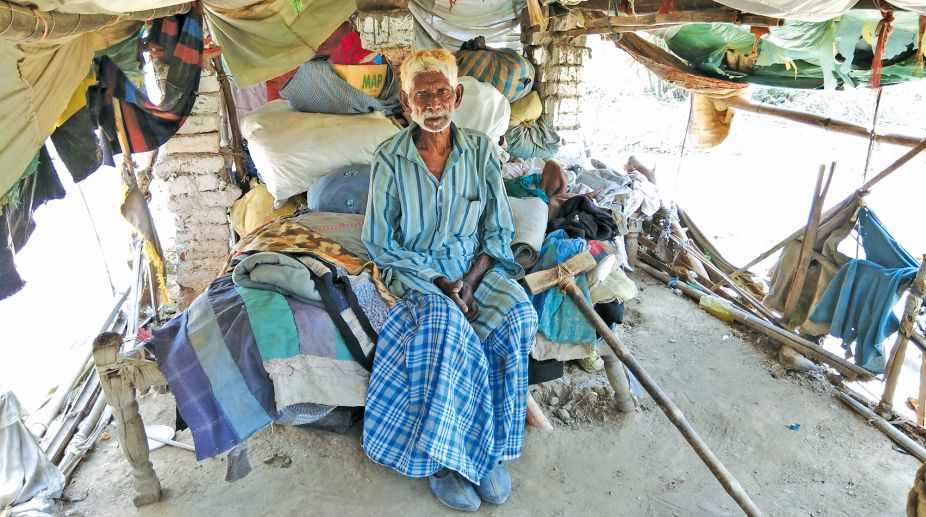Far away from the shrill debates on the quantum of employment generation, millions of livelihoods are being destroyed silently without causing much worry in the centres of power. This can be seen among artisans, informal sector workers and various marginalized communities including nomadic and semi-nomadic people.
The Kalandar community, traditionally nomadic, has been in the thick of such problems resulting in loss of livelihood and even identity to a large number of its members. We recently visited a settlement of this community in Tonk city of Rajasthan – ward 5 of Mohalla Bahir.
Advertisement
The overwhelming reality of around 110 families living here is that their traditional livelihood has been taken away without consulting them. At the same time the authorities have not taken any significant steps to replace the sudden loss of livelihood.
Till about five decades ago, this settlement was an important hub of community activities relating to rearing of bears and training them to entertain people with dance and role-play.
During the rainy season of three months, the families attached to this settlement gathered here to attend to various family and community tasks of marriage and other rituals, apart from settling disputes at community level. Then, by mutual consultation, they decided their routes and destinations and left in small groups of two or three families with their performing animal.
A remarkable but often ignored aspect of this life pattern was the close and affectionate relationship between Kalandars and their bears. As Noor Mohammad, an awardee of Democracy Fellowship who has been making relentless efforts for the welfare of his Kalandar community, says, “Kalandar families had a relationship of taking very good care of their bears.
They gave respect to their animals as the main providers of their livelihood. When a bear was ill, the Kalandar used to be desperate to arrange medical care. When anything delicious in the family was prepared, the bear got its proper share.
The food of the bear included, from time to time, rotis heavily dipped in milk, jaggery, honey and even ghee. The bears also showed their affection in many ways. There are many stories about how faithful bears were to the families that looked after them. In one instance when a person had to leave suddenly for some days, his bear refused to eat anything till he returned.”
The entertainment provided by bears was appreciated by countless villages untouched by modern means of entertainment. Here was an entertaining performance for which no ticket was needed, which even the poorest could see.
Payments were entirely on a voluntary basis yet accepted with folded hands. The bear not only danced but also played the role of a husband eager to please his wife, much to the delight of the assembled men, women and children.
And the laughter just could not stop when the bear turned to playing the role of a drunken person. Another aspect which took these performances beyond their entertainment value was the belief of many villagers that bears are descendents of Jambvat who provided support to Lord Rama. Hence, they sought blessings for their children from bears.
Several Kalandars to whom we spoke were at pains to emphasise that they were happy with their work. Wali Mohammad said, “Earnings of one member were enough to feed ten people.” Karim Baksh added, “Within our own domain we lived like kings, we had a carefree life, subservient to none.”
The family of Abdul Sattar had six bears. He says, “We were leading a very satisfactory and contented life at that time with hardly any complaints.”
Several Kalandars said that they got grain, pulses, oil and other commodities of daily use directly from their audiences, so they hardly had any need to buy from market. Villagers who sought the blessings of bears also gave them cash and auspicious coconuts.
All this changed in the 1970s when Kalandars heard that new forest and wildlife conservation laws had been enacted which placed heavy restrictions on their pattern of livelihood.
They were told either to get special licenses for their work or surrender their animals to authorities. They ran from pillar to post to get licenses but were turned away by state-level authorities who said that they could not get the necessary permission from the Centre.
There was panic when experienced Kalandars like Abdul Sattar were arrested. As fear spread regarding the possibility of arrest, Kalandars entered an unprecedented phase of crisis and confusion which started taking them away from their traditional way of life. In this situation and with a lot of pain and sadness they started surrendering their animals. The situation today is that there is not even a single bear left with this settlement.
As the traditional livelihood pattern crumbled, the authorities took no significant step to fill the void with new livelihood opportunities. Leaving aside some small efforts by an NGO, the Kalandars were more or less left to fend for themselves. This increased social distress and depression among community members and youths facing a precarious future,
This is the tragic story not just of one settlement or one community but of many communities and settlements in India that face the crisis of traditional livelihoods being snatched but no follow-up efforts to replace the loss by providing adequate new employment avenues.
In the cacophony of claims and counter-claims of how many jobs have been generated, will our centres of power find the time to listen to the anguish of those who have suffered huge loss of livelihood?
The writers are freelance journalists who specialise in development issues.











